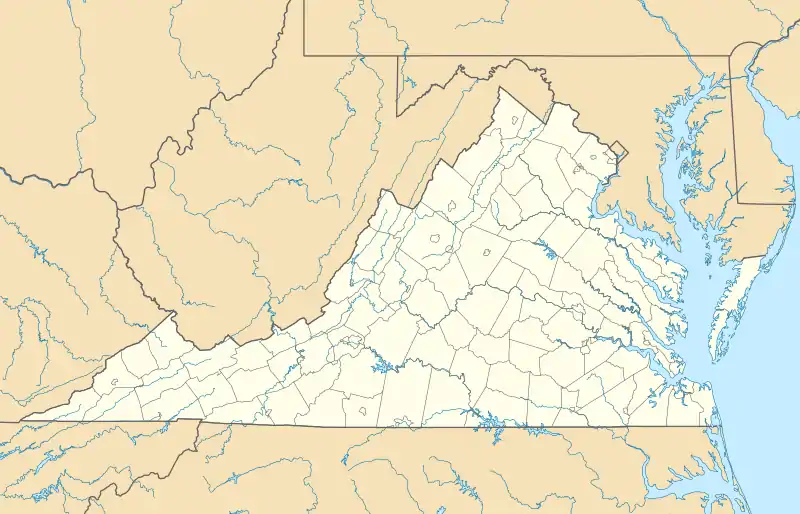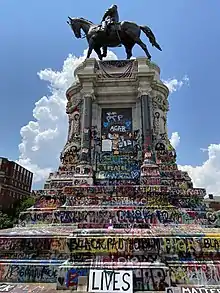Robert E. Lee Monument (Richmond, Virginia)
The Robert E. Lee Monument in Richmond, Virginia, was the first installation on Monument Avenue in 1890, where it remained the largest statue on the site for over a century. Since early July 2020, it survives as the last Confederate monument on the Avenue.[3] Ongoing legal proceedings have prevented the Governor of Virginia from removing the memorial; while an October 2020 ruling found the state had no obligation to maintain the monument, immediate action was halted pending appeal.[4][5]
Robert E. Lee Monument | |
 Statue atop the Robert E. Lee Monument | |
  | |
| Location | 1700 Monument Ave., jct. of Monument and Allen Aves., Richmond, Virginia |
|---|---|
| Coordinates | 37.55384°N 77.46012°W |
| Area | less than one acre |
| Built | 1890 |
| Architect | Mercie, Merius-Jean-Antonin; Pujol, Paul |
| NRHP reference No. | 06001213[1] |
| VLR No. | 127-0181 |
| Significant dates | |
| Added to NRHP | January 5, 2007 |
| Designated VLR | September 6, 2006[2] |
Description and location
The bronze statue, sculpted by Antonin Mercié, depicts Confederate general Robert E. Lee atop a horse. The horse is not a representation of Robert E. Lee's Traveller, as Mercié felt that its scale wouldn't fit with the overall composition. Lee stands 14 feet (4.3 m) high atop his horse and the entire statue is 60 feet (18 m) tall standing on a stone base designed by Paul Pujol.[6][7]
The state-controlled land around the statue serves as a traffic circle at the intersection of Monument Avenue and Allen Avenue (named after Otway Allen, the developer who donated the land to the association). The Lee Monument is a focal point for Richmond. (Most popular online maps depict the "Lee Circle" as the center of Richmond, although the United States Post Office uses the intersection of North and South Foushee Street where it intersects with East and West Main St as 0 axis Point of all address in the Richmond region, hence the true address center of Richmond. The Virginia Department of Transportation and the Virginia State Police use the state Capitol building as its center.)[8]
History

Following the death of Robert E. Lee in 1870, several organizations formed with the goal of erecting a monument to Lee in Richmond. These included survivors of Lee's Army of Northern Virginia, the Lee Monument Association led by Confederate general Jubal Early, and the Ladies' Lee Monument Association. These organizations were merged into the Lee Monument Commission in 1886, led by Lee's nephew and Virginia governor Fitzhugh Lee.[9][10]
The cornerstone was placed on October 27, 1887. The statue was cast in several pieces separately and then the assembled statue was displayed in Paris before it was shipped to Richmond, where it arrived by rail on May 4.[11] Newspaper accounts indicate that 10,000 people helped pull four wagons with the pieces of the monument. The completed statue was unveiled on May 29, 1890. [6]
The site for the statue originally was offered in 1886. Over some opposition, the offer was accepted and later withdrawn when opponents complained that the $20,000 for the Lee Monument was inappropriate because the site was outside the city limit. Richmond City annexed the land in 1892, but bad times economically caused the Lee Monument to stand alone for several years in the middle of a tobacco field before development resumed in the early 1900s.[6]
In 1992, the iron fence around the monument was removed, in part because drivers unfamiliar with traffic circles would run into the fence from time to time and force costly repairs. After the fences came down, the stone base became a popular sunbathing spot.[8] In December 2006, the state completed an extensive cleaning and repair of the monument.
It has been listed on the National Register of Historic Places since 2007, the Virginia Landmarks Register since 2006, and is located in the Monument Avenue Historic District.[1]
Controversy and removal

In 2017, after the violence that occurred at the Unite the Right rally, significant outrage and debate occurred relating to the monuments including the Lee statue in both Charlottesville and Richmond, Virginia.[12]
On June 4, 2020, Virginia governor Ralph Northam announced the statue would be removed in response to the protests that followed the May 2020 killing of George Floyd.[13] On June 8, a judge in Richmond Circuit Court issued a temporary injunction against the monument's removal, citing a lawsuit filed by William C. Gregory, who claims the Commonwealth promised to "faithfully guard" and "affectionately protect" the statue in the deed that originally annexed the property to the state.[14] Subsequent legal proceedings[15] led to a hearing on July 23, which concluded without a ruling on the monument's future.[16] A new 90-day injunction against the monument's removal began August 3.[17] After nearby residents filed a lawsuit to keep the statue in its place, Virginia's Attorney General filed a motion to dismiss the suit; circuit court Judge W. Reilly Marchant ruled August 25, 2020 that the matter would proceed to trial.[18][19] The October 19 trial[20] resulted in a halted decision pending appeal.[4]
Following Black Lives Matter protests in June, the traffic circle where the statue stands was unofficially updated with a sign that reads "Welcome to Beautiful Marcus-David Peters Circle, Liberated by the People MMXX" (after Marcus-David Peters, a Black man from Richmond who was shot and killed by the police in 2018).[21]
In October 2020 The New York Times wrote that the defaced monument was deemed among the most influential American protest artworks since World War II.[22]
See also
References
- "National Register Information System". National Register of Historic Places. National Park Service. July 9, 2010.
- "Virginia Landmarks Register". Virginia Department of Historic Resources. Retrieved 19 March 2013.
- Lawler, Andrew (2020-08-09). "The Black, Millennial Mayor Who Tore Down His City's White Monuments". Politico. Retrieved 2020-08-11.
- Vozzella, Laura (2020-10-27). "Northam can remove Lee statue in Richmond, judge rules". Washington Post. Retrieved 2020-10-28.
- "Richmond's Robert E. Lee Statue Can Come Down, but Not Yet, Judge Rules". The New York Times. 2020-10-28. Retrieved 2020-10-29.
- Carter, Robert A.; Murdock, Jennifer W. (August 2006). "National Register of Historic Places Inventory/Nomination: Robert E. Lee Monument" (PDF). Virginia Department of Historic Resources. and Accompanying four photos
- Mercie, Marius Jean Antonin; Pujol, Paul; Netherwood, James (24 October 1890). "Robert E. Lee Monument" – via siris-artinventories.si.edu Library Catalog.
- DuPriest, James E., Jr. and Douglas O. Tice, Jr., Monument & Boulevard: Richmond's Grand Avenues, A Richmond Discoveries Publication, Richmond, VA 1996 p. 8
- Foster, Gaines (1987). Ghosts of the Confederacy. New York: Oxford University Press. p. 52.
- "Robert E. Lee Monument, Richmond, VA" (PDF). January 5, 2007. p. 7–2. Archived from the original (PDF) on 21 October 2017. Retrieved October 21, 2017.
- DuPriest, James E., Jr. and Douglas O. Tice, Jr., Monument & Boulevard: Richmond;s Grand Avenues, A Richmond Discoveries Publication, Richmond, VA 1996 p, 6
- "How Richmond is addressing the debate over Confederate monuments 1 year after Charlottesville". ABC News. Retrieved July 8, 2020.
- Suderman, Alan; Rankin, Sarah. "Virginia governor to announce removal of Lee statue". Associated Press. Associated Press. Retrieved 3 June 2020.
- "Virginia Judge Blocks Plan To Remove Statue Of Robert E. Lee". Retrieved 2020-06-09.
- Amended lawsuit seeking to halt Robert E. Lee statue’s removal challenges Northam’s authority (July 9, 2020)
- Rankin, Sarah (2020-07-23). "Robert E. Lee statue stays on its Richmond pedestal, for now". WSLS. Retrieved 2020-07-24.
- Duster, Chandelis (2020-08-03). "Judge temporarily blocks Virginia attempt to remove Robert E. Lee statue in Richmond". CNN. Retrieved 2020-08-11.
- Kolenich, Eric (2020-08-25). "After judge's ruling, Richmond's Robert E. Lee statue will stay in place until at least October". Richmond Times-Dispatch. Retrieved 2020-09-30.
- Schneider, Gregory S. (2020-08-25). "Judge sets trial date for lawsuit blocking removal of Richmond's Robert E. Lee statue". Washington Post. Retrieved 2020-09-12.
- Schneider, Gregory S. (2020-10-19). "Trial will determine fate of Northam's effort to remove Richmond statue of Robert E. Lee". Washington Post. Retrieved 2020-10-25.
- Kolenich, Eric (2020-06-26). "Space around the Lee statue has been informally named for a Black man who lost his life at the hands of police". Richmond Times-Dispatch. Retrieved 2020-09-30.
- Force, Thessaly La; Lescaze, Zoë; Hass, Nancy; Miller, M. H. (2020-10-15). "The 25 Most Influential Works of American Protest Art Since World War II". The New York Times.
External links
 Media related to Robert E. Lee Monument (Richmond, Virginia) at Wikimedia Commons
Media related to Robert E. Lee Monument (Richmond, Virginia) at Wikimedia Commons